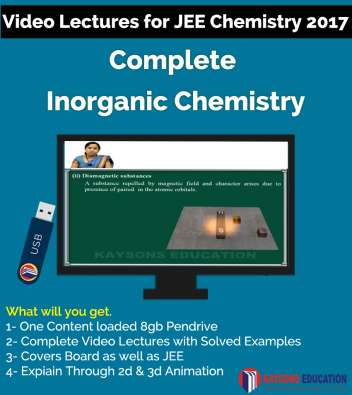Displaying 1-3 of 3 result(s).
About Course
-
Basic concept of periodic table:-
Day 1: Periodic Table, Classification of Element and Periodicity in Properties, Periodic Table, Periodicity of Properties, Cause of Periodicity, Electronic Configuration of alkali Metals, Electronic Configuration of Halogens, IUPAC Nomenclature Elements with at Number > 100.
Day 2: Main Characteristics of Periodic Table, Periods, Groups, Division of Elements into s, p, d, and f block elements, s – block elements, General Properties, p – block elements, General Character, General Properties, f – block elements, General Properties.
Day 3: Periodic Properties, Atomic Radius, Covalent Radius, Vander walls Radius, Metallic Radius, Generally, Along the period, Reason, Along the group, Isoelectronic Ions, Ionization Enthalpy/Energy, Unit, Successive Ionization Enthalpy, Factors Affected Ionization Energy, First ionization enthalpies of some elements (KJ mol–1).
Day 4: Electron Gain Enthalpy Δ_eg H, Characteristics, Reason for Positive e– Gain Enthalpy, Factors which affect Δ_eg H, Electron gain enthalpies of some elements in (KJ mol–1), Variation With in a Group, Important Point, Variation in a Period, Electro negativity, Electronegativities of representative elements (on the Pauling scale), Summary of Periodic Properties, Anomalous properties of second period element, Diagonal Relationship.
Day 5: Illustration.
Day 6: Illustration.
Metallurgy:-
Day 1: Ores and minerals, Important, Principal Minerals/Ores of some important metals, Extractive Metallurgy, Concentration of ore, Hydraulic washing / Levigation / Gravity Saperation, Electromagnetic Saperation, Froth Floatation Method, Principle, Working, Leaching/Hydrometallurgy.
Day 2: Conversion of ore into their oxides, Calcination, Benefits of Calcination, Roasting, Important Term, Flux, Reduction of Metallic Oxide into Crude Metal, Ellingham diagram, Application of Ellingham Diagram, Reduction of Metallic oxides, eq. Reduction of Cr2O3 to Cr metal by Al powder, Thermite welding process, Self reduction Method, Electrolytic Reduction Method, Continence from Carnelite, Hydrometallurgy, Cyanide Process (Oxidation Reduction Method).
Day 3: Refining, Zone. Refining, Vapour – Phase Refining, Conditions, Chromatographic Method.
Day 4: Metallurgy of Iron, Wrought Iron, Metallurgy of Copper, Extraction of copper from cuprous oxide, Bessemer Convertor.
Day 5: Metallurgy of Pb, Metallurgy of Zinc, Metallurgy of Tin (Sn), Metallurgy of Mg.
Day 6: Illustration.
Day 7: Illustration.
s-block elements
Day 1: 1st group ⇒ Alkali metals, Chemical Properties, Reactivity and electrode potential, Reason, Reactivity with water, Reactivity towards oxygen, Alkali metals get tarnished when exposed to air & moisture, Reactivity with H2, Reactivity with halogens, Solubility in liquid Ammonia, Oxides & hydroxides, Anomalous behaviour of Li, Similarities, Imp. Points.
Day 2: Extraction of Sodium, Down’s process, Extraction of Potassium, Sodium carbonate [washing soda] Na2CO3. 10H2O. [Solvay Process], Function of NH3, Properties of Na2CO3. 10H2O, Compounds of Sodium, Sodium Hydroxide, Properties by Castner & Kellner’s cell, Properties, Compounds of Sodium, Sodium Hydroxide, Sodium oxide (Na2O), Sodium peroxide (Na2O2), Sodium Sulphate Na2SO4.10H2O (Glauber’s salt), Microcosmic Salt [Na(NH4)HPO4].
Day 3: Oxides of Potassium, KO2, Preparation, Properties, Potassium Sesquioxide (K2O3), Potassium Hydroxide (KOH), Potassium Carbonate (Potash/Pearl ash), Preparation(Leblane process), Potassium Sulphate (K2SO4), Sodium bicarbonate NaHCO3, Biological importance of Sodium and Potassium.
Day 4: Alkaline Earth Metal, Atomic and Physical Properties of the Alkaline Earth Metals, Ionization Enthalpies, Hydration Enthalpy Be2+ > Mg2+ > Ca2+ > Sr2+ > Ba2+, Density, Flame Colouration, Chemical Reactivity, Reactivity Towards air & H2O, Reactivity towards halogens, Reactivity towards hydrogen, Reactivity towards acid, General Characteristics of the compound of the alkaline Earth metal, Halides, Carbonates of group Element, Sulphates, Nitrates, Anomalous Behavior of Be, Diagonal Behavior of Be and Al.
Day 5: Compounds of Mg, Magnesium Oxide MgO (Magnesia), Properties, Mg(OH)2, MgSO4.7H2O, Preparation, CaCO3, Preparation, Magnesium Chloride (MgCl2.6H2O), Preparation, Compounds of Calcium, Correct Increasing Order Of Some Properties With Their Hints / Explanation.
Day 6: Illustration.
Day 7: Illustration.
Product Details
-
1. 1 8 GB pendrive / Micro SD Card Contenting video lectures
2. 38 hours of video lectures
3. covering 11th and 12th syllabus as well as JEE
4. Dr. Shashi Bala ( M.Sc Ph.D from Lucknow University, Experience 16 Years )
5. Validity till 30th June 2017
Complete Product Details
-
Subject : Chemistry for jee mains and advance
Class : 11th and 12th
Course Doration : 21 Hours
Validity : 17-Jun
Chapters : Inorganic Chemistry, Periodic Table, Metallurgy, S-Block Elements, p-block elements, d-Block Elements,Coordination compounds
4016913914
|


